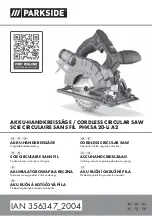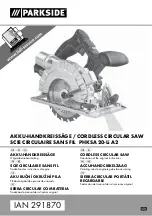
12
blade at the same time until it locks into position.
6. Use the wrench (included) to turn the threaded blade screw clockwise, and
remove the threaded blade screw.
7. Remove the outer flange and the blade. Wipe the flanges and spindle in order
to remove any dust and debris.
Installing the blade
IMPORTANT: Do not use thin-kerf blades.
Thin-kerf blades can deflect and
contact the guard, which can cause injury to the operator.
1. Unplug the saw.
2. Ensure that the inner flange is properly installed.
3. Match the arrow on the blade with the arrow on the upper blade guard. Make
sure the teeth of the blade are pointing downward. Install the selected blade
by sliding the blade into the upper blade guard and then placing the blade
into position.
4. Install the outer flange.
IMPORTANT:
Make sure the flat side of the flange is placed against the blade.
5. Press and hold the spindle-lock button, and use the wrench (included) to turn
the blade screw counter-clockwise until the lock engages. Securely tighten
the blade screw.
6. Rotate the blade-screw guard into position, and use the screwdriver to
securely tighten the screw by turning it clockwise. Remove the wrench, and
store it in a safe place.
7. Make sure the spindle-lock button is released so that the blade will rotate
freely.
8. Lower the saw head, and check the clearance between the blade and the
miter table. The blade should rotate freely.
Installing extension wings
The extension wings support long
workpiece during cutting. (fig. 5)
1. Insert both rails of an extension
wing through the holes on the
outside of the Miter Saw base.
2. Tighten the wing screw that locks
the extension wing in position.
Make sure the extension wings do
not move.
Fig. 5













































